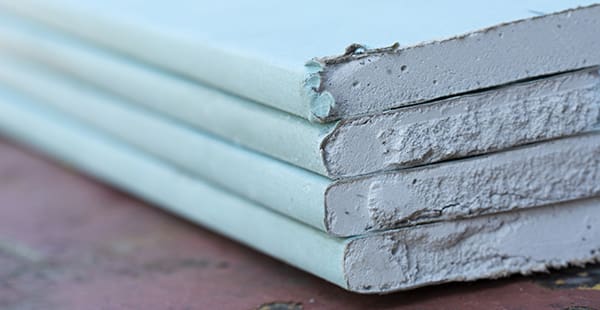Why Was Asbestos Used in Drywall Products?
For decades, construction manufacturers produced drywall materials with asbestos. It was an affordable way to make drywall lighter, stronger and more fire-resistant. Builders used these materials in many commercial, residential and military buildings. Homeowners may also handle these asbestos drywall materials during do-it-yourself repairs or renovations.
Before the 1980s, companies used asbestos with drywall materials in various ways. Asbestos was often part of the drywall mixture itself.
The mineral was also used in materials like joint compounds. This is either a pre-mixed paste or a powder that water is added to. It is used to seal the seams between drywall panels. Construction workers may also have used joint compound for smaller wall patches and repairs.
By the 1980s, asbestos regulations limited the use of asbestos in materials like drywall. Companies in the United States could no longer produce or use asbestos-containing drywall or joint compound. But existing buildings constructed before the 1980s may still contain asbestos construction products.
Asbestos Drywall History at a Glance
- Other Names: Gypsum board, plasterboard, sheetrock, wallboard
- Years of Manufacture: 1916 – 1970s
- Military Use: Barracks and other buildings for the Air Force, Army, Marines, Navy
- Places Used: Businesses, factories, homes, offices, retail stores, schools
- Asbestos Use Banned: Partial ban
- Noteworthy Brands: Bondex International, Georgia-Pacific Corporation, Kaiser Gypsum Company Inc., National Gypsum Company, U.S. Gypsum Company
What Types of Asbestos Sheetrock and Compounds Are Banned?
In 1977, the U.S. Consumer Product Safety Commission (CPSC) set a partial asbestos drywall ban. The Commission banned patching compounds containing asbestos for consumer use. At the time, asbestos was in about half of all patching compounds. The product labels did not disclose this risk to consumers. The ban did not extend to all types of drywall products.
Dangers of Asbestos in Drywall and Finishing Materials
Anyone who handles asbestos products or materials faces a risk of asbestos exposure. Activities that disturb asbestos fibers increase the risk of exposure. This includes making, installing or repairing drywall boards and finishing materials.
Workers often cut, mix, sand and sweep drywall materials. This can release asbestos dust, leading to exposure. Testing shows the primary type of asbestos in drywall materials is chrysotile. This type comprises 90% – 95% of asbestos used in buildings in the United States.
Some research from the 1970s to the 1980s has shown asbestos air fiber measurements in drywall to be above regulation limits at the time of their usage. This research also showed typical asbestos-related diseases, like mesothelioma, in drywall construction workers.
A 2012 study found that demolishing or repairing wallboard may disturb asbestos joint compound. The study stated these materials continue to be potential sources of exposure. Any craftspeople or homeowners can discuss suspected asbestos drywall exposure with their doctors.
List of Wallboard, Gypsumboard and Other Asbestos Drywall Products
Many companies that manufactured construction products once used asbestos. The mineral’s heat resistance and durability made it popular for materials like drywall and its finishing products.
All the various types of drywall materials and layers may have contained asbestos. The most common asbestos drywall components include:
- Acoustical and patching plasters
- Ceiling panels
- Drywall and vinyl base adhesives
- Finishing compounds
- Joint system cements
- Joint wall compounds (or muds)
- Laminating and joint topping compounds
- Liquid adhesives
- Plasterboards
- Sheetrock or gypsum boards
- Spackling compounds
- Tapes
- Wall and ceiling surfacing textures
Many well-known manufacturers once made these asbestos drywall products. For years, these companies put people at risk of asbestos exposure. After regulations began, they stopped using the mineral in their U.S. product lines. Homeowners and construction workers may still face these risks in older buildings and homes.
Who Is at Risk of Asbestos Exposure From Drywall Materials?
The use of asbestos drywall materials may have led to occupational exposure for many people. These workers were often involved in the construction industry or a related field. For example, both carpenters and painters may have been exposed to asbestos through drywall materials, like joint compound and wallboard. Veterans of all military branches may have experienced exposure in barracks and other buildings. Homeowners may have also experienced non-occupational exposure to asbestos drywall materials when doing home repairs or renovations.
By the 1980s, new drywall products did not contain asbestos. But older drywall materials still present an exposure risk. Workers, homeowners and renters may all face risks when renovating or repairing older buildings. Asbestos exposure may lead to mesothelioma and other asbestos cancers.
Asbestos Lawsuits, Settlements & Other Compensation
People who have been exposed to asbestos drywall materials may have legal rights. Mesothelioma lawyers can review exposure details and help victims understand their best options. These options may include mesothelioma lawsuits, workers’ compensation claims and bankruptcy trust fund claims.
Many construction companies that produced asbestos drywall have asbestos trust funds. These funds exist to compensate current and future asbestos claims. Based on their work and exposure history, victims may be able to file bankruptcy claims against asbestos companies. Asbestos drywall companies with bankruptcy trust funds include:
- Bondex International
- The Flintkote Company
- Georgia-Pacific Corporation
- National Gypsum Company
- U.S. Gypsum Company
- W.R. Grace / Zonolite
Compensation Following Exposure From Asbestos Drywall-Related Products
People may develop mesothelioma after asbestos exposure through drywall and finishing materials. Many victims have received mesothelioma compensation from lawsuits against asbestos drywall companies. This financial compensation may come from mesothelioma settlements or verdicts. Some successful lawsuits for mesothelioma and asbestos materials, like joint compound, include:
- A 2012 lawsuit against a construction company called Tishman Liquidating Co. (Tishman). The mesothelioma victim worked with drywall at two of the company’s projects in New York from 1975 to 1977. The jury found that the joint compound contained unsafe levels of asbestos, which Tishman should have known. The company failed to use reasonable care and acted with reckless disregard. The jury awarded the victim $19 million.
- A 2009 lawsuit against Georgia-Pacific and other drywall product manufacturers. The mesothelioma victim and her husband ran a construction business for decades. The victim’s main work duty was applying joint compound between drywall panels. Then she would sand, reapply and sand again. This process created asbestos dust that the victim inhaled regularly. A jury awarded the victim and her husband $6.2 million.
Safely Removing Asbestos Drywall Materials
Asbestos may be present in buildings constructed before the 1980s. Homeowners or workers may be renovating or repairing drywall in these buildings. Some specific protocols to follow when working with potential asbestos drywall materials include:
- Only asbestos professionals should test for asbestos presence.
- For suspected asbestos drywall, homeowners or contractors should consult with state-accredited asbestos inspection firms.
- Homeowners should not handle or remove asbestos themselves.
- Asbestos abatement professionals are available for hire. They will follow laws for handling and disposing of asbestos drywall materials.
The Environmental Protection Agency (EPA) also created specific asbestos work practices. These practices are part of the National Emission Standards for Hazardous Air Pollutants (NESHAP). These standards establish processes to help release fewer asbestos fibers during construction activities.
If demolition or renovation impacts a wall system, the EPA requires a composite analysis. This wall system analysis includes drywall components like joint compound, tape and wallboard. If the analysis shows more than 1% asbestos, the project must follow the EPA’s NESHAP guidelines.
Common Questions About Asbestos Drywall
- Does drywall have asbestos today?
Drywall products have not contained asbestos since the 1980s. But many pre-1980s drywall products may contain asbestos. Remodels, repairs, demolition and normal wear and tear can all pose exposure risks. Hire an abatement professional to test your home before making structural changes.
- How can you tell if drywall has asbestos?
It’s almost impossible to identify asbestos sheetrock by looking at it, but pre-1980s buildings are likely to contain it. The surest and safest way to know if your drywall has asbestos is to hire a professional asbestos inspector to test it. DIY testing can put you at risk of exposure, which can lead to diseases like mesothelioma.
- Can you put drywall over asbestos?
Putting another layer of drywall over asbestos drywall risks releasing dangerous fibers into the air. Instead of removing asbestos from your home, asbestos contractors can also encapsulate it. Encapsulation means applying sealant to undamaged asbestos products, including drywall. If fibers can’t become airborne, it’s generally considered safe.






